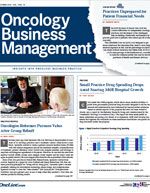Publication
Article
Oncology Business News®
An Age of Exciting New Medicine That Many Cannot Afford
Author(s):
Consolidation in the insurance industry and the pace of the rise in cost of general and specialty pharmaceuticals are the 2 factors in the healthcare industry that will most affect access and affordability.
Andrew L. Pecora, MD
Editor-in-Chief of Oncology Business Management
Chief Innovations Officer, Professor, and Vice President of Cancer Services John Theurer Cancer Center at Hackensack University Medical Center
President, Regional Cancer Care Associates, LLC
As the holiday season rolls in, one can imagine the conversation around the family table when a loved one expresses grief that they have a serious-to-life-threatening medical problem. Adding to the shock, they tell you that the illness can be effectively addressed with some new drug or procedure but because of their new high deductible and 20% co-pay insurance plan, the care is not affordable.
Situations like this are becoming more common. Consolidation in the insurance industry and the pace of the rise in cost of general and specialty pharmaceuticals are the 2 factors in the healthcare industry that will most affect access and affordability.
A few important facts need be reviewed to put into perspective this problem being shared by a growing number of Americans. In a 2012 edition of the Journal of the American Medical Association, Don Berwick and colleagues published a study of the waste in US healthcare expenditures, by category, for 2011. A staggering $558 billion to $1263 billion was wasted of approximately $3 trillion spent, according to the study. Waste categories included overtreatment, failures in care coordination and delivery, excesses in administrative and healthcare pricing cost, and fraud and abuse.
If this is not bad enough, add to it that health spending per capita in 2013 was highest in the world ($8600) and yet more than 20 other nations had greater life expectancy (US<80 vs >80 years), and some of those countries spent less than half per capita. In fact, had we spent in annual healthcare what the next highest spender per capita (Sweden) did over a 4-year period, the United States could have saved $15.5 trillion.
A new problem is adding fuel to the fire: the rapid rise in cost of general and specialty pharmaceuticals. Recent data from Express Scripts showed that the cost of a 30-day supply of Humulin (insulin) by 2013 had risen by 325% compared to 2010 ($1097 vs $258). New potentially life-saving drugs have entered the market, but the cost may be prohibitive considering deductibles and co-pays. Every new oncology drug approved in 2014 exceeded $120,000 per year, and a hepatitis C medication costs $94,000. Recent estimates show the cost of specialty pharmaceuticals increasing at 2.2% per month.
A famous economist once said that what cannot continue to increase will not. Let’s see—an ever-increasing percentage of GDP and less than the best outcome compared with other nations, now made unaffordable by new less-expensive insurance plans with high deductibles and co-pays.
Something has to give and it has started. Companies like Walmart and Target, not known for expertise in healthcare, have alleviated part of the problem by delivering basic care much less expensively and far more conveniently than medical practices. Also, companies like CareMark CVS and Walgreens are known for drug sales but soon will be known for primary care, and this is just the beginning.
For many individuals, it may seem like a good idea to buy a less expensive insurance plan; however, there may be cause for regret later if they develop costly diseases like cancer. Oncologists are struggling to help their patients. Patient assistance programs, charity care and other measures do not completely fill the gap.
I, for one, cannot believe we have come so close to curing many cancers only to have our patients not be able to afford it. It seems to me like we need a complete overhaul—and quickly. We need to reward elimination of wasteful spending, promote alternative sites of care when clinically appropriate, and have supplemental insurance vehicles for catastrophic care with reasonably priced pharmaceuticals and procedures. Expenditures will not keep rising in healthcare—they cannot.








